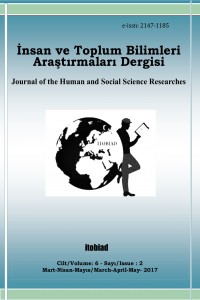Abstract
Bir dili oluşturan aslî unsurlar sadece
isimler, fiiller ve bunlara yardımcı olan öğeler değildir. Bir romanda,
okuyucuyu cezbeden bir dil oluşturabilmek için en sık başvurulan yöntemlerden
biri, ikilemeleri yani tekrar gruplarını kullanmaktır.
Amacı bir cümlede aynı türden
kelimeleri arka arkaya getirerek anlamı kuvvetlendirmek ve zenginleştirmek olan
ikilemeler, Türk dilinin ifadesinde önemli rol oynamaktadır. Edebiyatımıza
birçok eser kazandıran yazar Kudret Ayşe Yılmaz’ın ilk romanı olan
Orobanhiyye’de ikilemeler sıkça kullanılmıştır. Yazarın dilini kuvvetlendiren,
okuyucu ile sıcak bir bağ kurmasını sağlayan unsurlardan biri, romanda tekrar
gruplarının çokça kullanılmasıdır.
Türk dilinin
anlatımına güç ve canlılık katan ikilemelerin, çalışmamızda incelediğimiz
Kudret Ayşe Yılmaz’ın ilk romanı olan Orobanhiyye’deki sayısı 209’dur. Bu ikilemeler
tekrarlarıyla birlikte 287 farklı yerde kullanılmıştır. Anlam ve yapısal olarak
iki ana başlık altında incelediğimiz bu ikilemelerin romanın anlatımına kattığı
zenginlik, yaptığımız bu çalışmada ikilemelerin cümleye kattığı anlamları da
verilerek gösterilmeye çalışılmıştır.
References
- Aksan, Doğan, “Göktürk Yazıtlarında Söz Sanatları-Güçlü Anlatım Yolları”, Türk Dili Araştırmaları Yıllığı Belleten, (1994): 1-12.
- Ergin, Muharrem, Türk Dil Bilgisi, İstanbul: Bayrak Yayınları, 2002.
- Sev, Gülsel, “Dîvânu Lügâti’t-Türk’te İkilemeler” Türk Dili ve Edebiyatı Dergisi 634, (2004): 497-510.
- Tokay, Yaşar, “Evliyâ Çelebi Seyahat-nâmesi’nde İkilemeler”, Turkish Studies Dergisi 8/9, (2013): 2401-2416.
- Üstünova, Kerime, “Dede Korkut Destanlarında Aralıklı İkilemeler”, Türk Dili ve Edebiyatı Dergisi 557, (1998): 464-470.
- Yılmaz, Kudret Ayşe, Orobanhiyye, İstanbul: Ötüken Yayınları, 2012.
Abstract
The primary
components which consist of a language are not only names, verbs and elements
lending assistance to these. One of the most referred methods in a fiction to
form a language which attracts reader is to use reduplications, in short,
repetition groups. The reduplications
whose objective is to strengthen and enrich meaning by stringing words of a
sort together in a sentence plays key role in expression of Turkish language.
In Orobanhiyye, the first fiction of author Kudret Ayşe Yılmaz who gains may
works to our literature, reduplications are used frequently. One of the elements that invigorates expression of an
author, ensures she establishes a cordial connection with reader is widely use
of repetition groups in a fiction. In Orobanhiyye, the first fiction of Kudret
Ayşe Yılmaz that we have viewed in our study, the number of the reduplications
which adds power and vitality to expression of Turkish language is 209. These
reduplications are encountered in 287 different places along with their
repetitions. The richness attached to the fiction by these reduplications we
study under two main titles, meaning and structure is tried to be shown by also
giving the meanings that the reduplications include in sentence in this study
we have conducted.
References
- Aksan, Doğan, “Göktürk Yazıtlarında Söz Sanatları-Güçlü Anlatım Yolları”, Türk Dili Araştırmaları Yıllığı Belleten, (1994): 1-12.
- Ergin, Muharrem, Türk Dil Bilgisi, İstanbul: Bayrak Yayınları, 2002.
- Sev, Gülsel, “Dîvânu Lügâti’t-Türk’te İkilemeler” Türk Dili ve Edebiyatı Dergisi 634, (2004): 497-510.
- Tokay, Yaşar, “Evliyâ Çelebi Seyahat-nâmesi’nde İkilemeler”, Turkish Studies Dergisi 8/9, (2013): 2401-2416.
- Üstünova, Kerime, “Dede Korkut Destanlarında Aralıklı İkilemeler”, Türk Dili ve Edebiyatı Dergisi 557, (1998): 464-470.
- Yılmaz, Kudret Ayşe, Orobanhiyye, İstanbul: Ötüken Yayınları, 2012.
Details
| Journal Section | Articles |
|---|---|
| Authors | |
| Publication Date | August 19, 2017 |
| Published in Issue | Year 2017 Volume: 6 Issue: 3 |


